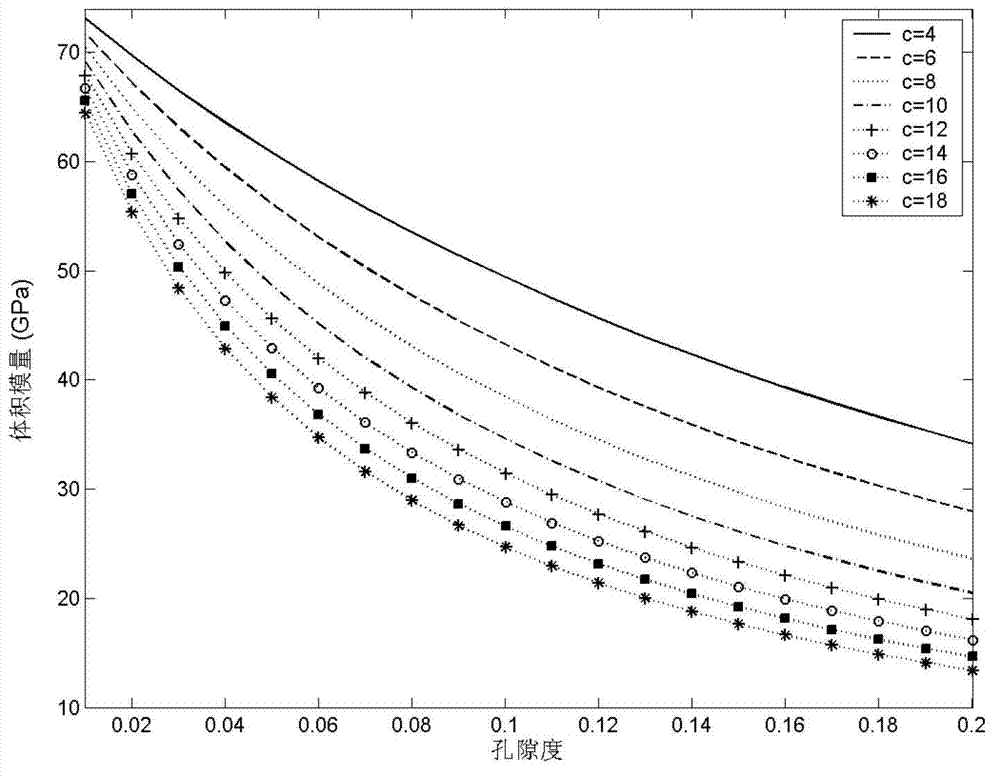Multi-scale rock physical charting method and device for detecting reservoir hydrocarbon
A petrophysical, multi-scale technology, applied in the field of petrophysical models and seismic data inversion and interpretation, it can solve the problems that cannot be applied to multi-scale waveform data, cannot achieve quantitative inversion of reservoir rock parameters and fluid saturation, and cannot. Meet the problems of non-uniform and complex formation engineering applications, etc.
- Summary
- Abstract
- Description
- Claims
- Application Information
AI Technical Summary
Problems solved by technology
Method used
Image
Examples
Embodiment 1
[0111] Example 1: Theoretical prediction results of bulk modulus and shear modulus of rock skeleton
[0112] Taking limestone as an example, if the rock matrix is mainly composed of calcite and a small amount of mud, and different consolidation parameters c and c are selected, the relationship between the volume and shear modulus of the dry skeleton of the rock with porosity is as follows: Figure 2A Figure 2B shown. The elastic parameters of the rock skeleton decrease as the porosity increases, and the decreasing trend becomes more obvious as the consolidation degree of the rock becomes weaker. The degree of consolidation of the rock can be determined according to the specific conditions of the reservoir.
Embodiment 2
[0113] Example 2: Theoretical Calculation Results of P-wave Velocity and Attenuation of Gas and Water-bearing Rocks
[0114] Taking limestone as an example, the parameters of the rock skeleton are: porosity 0.16, skeleton bulk modulus 24.81GPa, skeleton shear modulus 11.79GPa, permeability 30.23mD, and average bubble size 5mm. The rock matrix is calcite, and the reservoir temperature, fluid density under pressure and elastic parameters can be estimated according to van der Waals. Figure 3A and Figure 3B The P-wave velocity in unsaturated limestone at different frequencies is given ( Figure 3A ) and attenuation ( Figure 3B ) with water saturation. For the same piece of limestone, the relationship between P-wave velocity and water saturation is significantly different at different frequencies. , the P-wave velocity increases approximately linearly and monotonically with the increase of water saturation.
Embodiment 3
[0115] Example 3: Comparison of petrophysical charts and experimental data
[0116] Figure 4A and Figure 4B The comparison results between the corrected petrophysical plates and experimental data in different frequency bands are given ( Figure 4A is the ultrasonic frequency band, Figure 4B below the sonic frequency band). In Figure 4~ Figure 6 In , the por marked on the plate indicates porosity, Sw indicates water saturation, and SampleA~G indicate seven carbonate rock samples. exist Figure 4A and Figure 4B In , the scatter color scale represents the water saturation (Sw), the darker the color, the higher the water saturation, black is 1 (completely water-containing), white is 0 (completely gas-containing). The wave velocity observation results of carbonate unsaturated experiments published in previous literatures are rare, especially the experimental data below the acoustic frequency band (including the seismic frequency band) is relatively rare. Figure 4A and...
PUM
| Property | Measurement | Unit |
|---|---|---|
| Bulk modulus | aaaaa | aaaaa |
| Shear modulus | aaaaa | aaaaa |
| Permeability | aaaaa | aaaaa |
Abstract
Description
Claims
Application Information
 Login to View More
Login to View More - R&D
- Intellectual Property
- Life Sciences
- Materials
- Tech Scout
- Unparalleled Data Quality
- Higher Quality Content
- 60% Fewer Hallucinations
Browse by: Latest US Patents, China's latest patents, Technical Efficacy Thesaurus, Application Domain, Technology Topic, Popular Technical Reports.
© 2025 PatSnap. All rights reserved.Legal|Privacy policy|Modern Slavery Act Transparency Statement|Sitemap|About US| Contact US: help@patsnap.com



